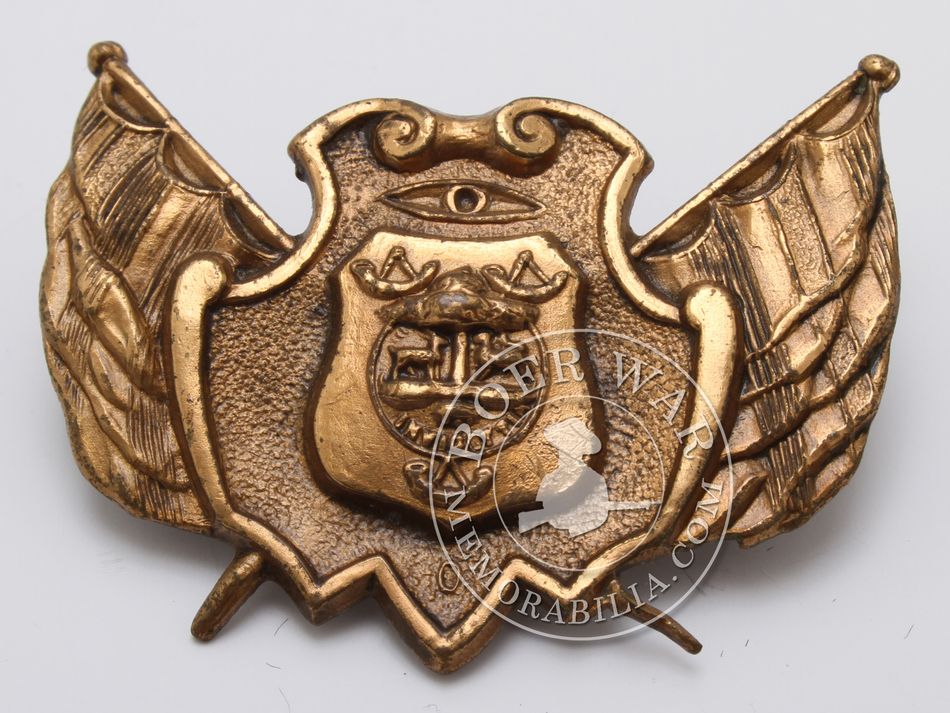|
View the embedded image gallery online at:
https://boerwarmemorabilia.com/index.php/memorabilia/military-insignia/item/105-ovs-badge-3-boer-forces#sigProIdc4ecf9ff68 |
Item Ref# KS6128
OVS Badge 3 - Boer Forces
Brief description: This small polished brass badge was worn by the Oranje Vrystaat Artillerie Corps (OVSAC). Note that it is brass badge without the scroll beneath it. It was typically pinned to the front of a peaked cap of NCO’s artillerists (dark blue cloth with black cap band with orange piping). The Signaller’s wore the same cap, but with an additional bundle of lightning rods above the coat of arms. Sergeants and Sergeant-Majors wore these badges on their collars. In the field, NCO’s wear a blue undress cap for early war impressions. This peaked cap was made from dark blue cloth with a black cap band. The crown as well as the top and bottom of the black band were finished off in orange piping. The small German style visor was made of polished leather and had top and bottom bead edges. A small polished brass Free State coat of arms badge, without the scroll, was pinned to the front of the cap. The signal unit wore an additional “bundle of lightning rods” signal unit badge above the coat of arms. Furthermore, this badge was also worn on the collar by the OVS police and above the rank insignia (stripes) of an OVS police sergeant. Material: Brass |

OVS Artillery Piece - Armstrong & Co 12 Pounder (1866)
In 1879, after several years of peace, the downsizing of the Free State Artillery was called for. In the same time the British Colonial Government got involved in a war against the Zulus and a dispute with the Basothos at Morosi’s mountain. The Friend of 1 May 1879 wrote:
“We understand that the Colonial Government (Cape Colony), a few days ago, applied to our Government for a loan of ammunition- or offered to buy the same- for some cannon which are at Morosi’s mountain, and the President and Executive at once consented to supply our Colonial cousins with the same at cost price.”
It seems that the small 7-prs in use with the Colonials were useless in battering down the breastworks of Morosi’s stronghold and so on the same day the Colonial Secretary for Native Affairs, William Ayliff, accompanied by Captain Giles of the Royal Artillery, arrived in Bloemfontein to obtain a heavier gun. The Free State Government offered either to lend the 12-pr to the Cape Government or to sell it at cost price. Ayliff decided on the latter and the complete gun and ammunition was made over for £1,241-11-1 (some say £1,030).
In British hands the 12-pr reportedly bombarded Morosi’s mountain on 4 June 1879. On the 5th an attempt was made to storm the stronghold and although the guns managed to batter down one of the walls, the attack failed. On 17 November the 12-pr was again in action and bombarded the stronghold for three days until its surrender on the 20th. The gun presumably again saw action against the Basotho in the Cape Colonial-Basotho “Gun War” (1880-1881).
Fortunately this gun also survived and until recently it could be viewed outside the East London City Hall. Its trunnion inscriptions read:
Sir WG Armstrong & Co / No.1421 / 1866 and Weight 983 lb / 12 pr / Prep 13 lb.
Unfortunately, an underhanded move by a City official saw to it that this priceless piece, as well as a Boer War Hotchkiss, was dumped at a local scrap yard! Artillery enthusiasts rose to the occasion and ensured that the remains of the pair was salvaged and placed in the care of a local military regiment. The City official was also fired. The pair will hopefully be restored to their former glory in the near future. Together with the Ladysmith 9-pr, this 12-pr is an extremely rare example of Armstrong’s early RML experimental guns and should be preserved at all cost.
ORANJE VRIJSTAAT ARTILLERIE CORPS/ Historical Study and Re-Enactment Group
| Scripture |
|
For God has not given us a spirit of fear, but of power and of love and of a sound mind. 2 Timothy 1:7 |

